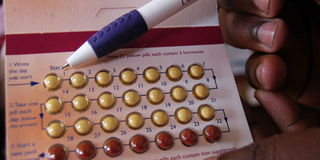Kenya revises family planning target upwards

Contraceptives at a health centre. Kenya has recorded an increase in use of contraceptives from 53 per cent in 2014 to 59 per cent in 2017. PHOTO| FILE | NATION
The use of contraceptives has increased six per cent from 53 per cent in 2014 to 59 per cent in 2017, according to new data from the Ministry of Health, showing that Kenya has surpassed its 2020 target of 58 per cent.
This has informed the ministry’s decision to revise its contraceptive prevalence rate to 66 per cent by 2030 and 70 per cent by 2050.
Contraceptive prevalence rate is the percentage of women of reproductive age (15 to 49 years) using a modern contraceptive method.
Data presented during World Population Day on July 11 also showed that use of long-acting methods (injections, intra-uterine devices and implants) has increased from 14 per cent in 2014 to 25 per cent in 2017.
Further, demand satisfied by modern methods among all women rose from 68 per cent to 76 per cent, while that of married women rose from 68 per cent to 78 per cent.
Presenting a report from 11 counties, Prof Peter Gichangi, the Country Director of the International Centre for Reproductive Health, said that unmet need for family planning among women aged 15 to 49 years decreased from 17.9 per cent 2014 to 14.9 in 2017, according to the Performance Monitoring and Accountability (PAMA) 2020 platform.
Unmet need refers to number of sexually-active or married women who would like to delay childbearing or space births, but are not using birth control.
BUDGET
“Unmet need for limiting the number of children decreased from 9.2 to 7.5 per cent while unmet need for spacing decreased from 8.3 in 2014 to 8.2 per cent in 2017,” said Prof Gichangi.
The eleven counties under review were Bungoma, Kakamega, Kericho, Kiambu, Kilifi, Kitui Nairobi, Nandi, Nyamira, Siaya and West Pokot.
Bungoma registered an increase in use of contraceptives from 53.9 in 2014 to 64 per cent in 2017; Kakamega from 60.3 to 70.3 per cent; Kericho from 56.9 to 63 per cent; Kilifi from 32 to 41 per cent; Kitui from 55 to 60 per cent; Nairobi from 58.3 to 64.6 per cent; Nandi from 59 to 60 per cent; Nyamira from 64 to 66 per cent; Siaya from 50 to 57 per cent and West Pokot from 13.3 to 19 per cent.
Only Kiambu County registered a small decrease from 67.8 per cent in 2014 to 65.4 per cent in 2017.
However, despite the increase in the uptake of modern contraceptives, investment in the sector has been insignificant with donor contribution to the sector declining.
Moreover, contraceptives are not included in the National Hospital Insurance Fund (NHIF) cover.
Even though the government increased the contraceptive budget to Sh700 million in 2017, Josephine Kibaru-Mbae the Director General of the National Council for Population and Development said Kenya needs Sh2.3 billion to budget for contraceptives for all women in the country.
Dr Joel Gondi, the head of reproductive and maternal health services unit, explained that donor funding declined when Kenya was elevated to a middle-income country, which saw donor contribution to family planning reduced from $7 million to $1 million.
“Counties are not investing much in family planning hence putting so much pressure on their availability and the operations of the sector,” he said, noting that that family planning commodities were competing with other budgetary allocations, making it difficult to fill the gap.


